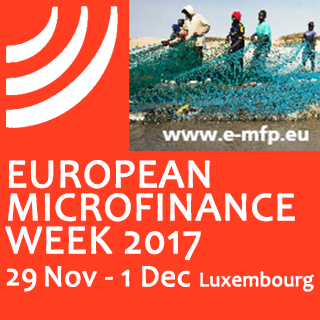During the closing day of European Microfinance Week,  Karima Wardak of the UN Capital Development Fund argued that copying digital financial services from country to country is not working. The same is true of country-specific “products that were designed in board rooms,” she said. Gilda Zarate Chabluk of Innate Motion, a consultancy with staff in 27 countries, launched the discussion of how concepts of human-centered design can sidestep these problems. All staff involved in a project should observe and talk to end-users early in the design process. She suggests a meeting at the home of the end-user that lasts about two hours, with most of that time focused on the user’s life rather than the product. The idea is to create the product with the users not for the users.
Karima Wardak of the UN Capital Development Fund argued that copying digital financial services from country to country is not working. The same is true of country-specific “products that were designed in board rooms,” she said. Gilda Zarate Chabluk of Innate Motion, a consultancy with staff in 27 countries, launched the discussion of how concepts of human-centered design can sidestep these problems. All staff involved in a project should observe and talk to end-users early in the design process. She suggests a meeting at the home of the end-user that lasts about two hours, with most of that time focused on the user’s life rather than the product. The idea is to create the product with the users not for the users.
Ms Wardak gave an example of replicating a product from South Africa to Zambia. Users in Zambia found the South African password system unworkable. The fact that this was a surprise to developers supports Ms Wardak’s contention that “it’s not just your marketing team that should go to the field.”
Lisa Chassin of PHB Development, a Belgian firm focussed on financial inclusion, described a project in Benin supporting South Africa’s MTN Group in rolling out a digital wallet. MTN had already planned to target the tens of thousands of Zemidjam motorbike-taxi drivers in the country because they tend to know the neighborhood gossip and thus would be likely to spread the product to others. MTN also thought they knew what Zem drivers wanted: insurance in case they are injured. This is not an unreasonable guess considering the dangers of their job.
However, through the process of engaging Zem drivers in the design of the digital wallet, MTN learned they had more pressing priorities. Chief among these was the security of the cash they carry, which might fall out of a pocket or be stolen by a customer riding immediately behind them on the motorbike. Other potential products of interest were a way to manage tontine savings groups, in which many of the Zem drivers were already participating; accepting electronic payments to avoid the problem of making change, which is often difficult for people without bank accounts; and how to save enough cash for the next tank of gas.
The presenters quoted Jamelino Akogbeto of the UN Capital Development Fund as saying, “When we launched the payment project, we were all convinced that convenience was the key value, but then we learned it was security.”
Ms Chassin explained another project with Senegal’s Ministry of Finance to manage pension payments for 30,000 retirees. The existing system required them all to appear in person at a certain office within five days each month, often waiting in the heat for long periods. The Ministry was concerned, however, that moving to digital payments would deny the retirees an important social outlet that the monthly office visits provided.
Ms Zarate Chabluk explained that meeting with the beneficiaries revealed that travel costs were a concern and the social aspect was not valued. In fact, many of the retirees felt shame at their diminished status of no longer being providers to their families and communities.
Ms Wardak explained that the design process resulted in a pilot with three different service options targeted at those with more and less interest in trying new technologies.
This interview is part of a sponsored series on European Microfinance Week, which was held in Luxembourg from November 29 through December 1. MicroCapital was engaged to promote and cover the event on-site.
Sources and Additional Resources
European Microfinance Week 2017
http://www.e-mfp.eu/european-microfinance-week-2017/information
MicroCapital Coverage of European Microfinance Week Since 2012
https://www.microcapital.org/category/european-microfinance-week/
Similar Posts:
- SPECIAL REPORT: Enabling Microinsurance via Technology: RFID Tags Slash Fraud, Costs of Livestock Cover in Rwanda
- SPECIAL REPORT: Digitizing Microfinance to Meet Customer Needs via an Incremental Approach #EMW2023
- MICROCAPITAL BRIEF: China Mobile’s Zong Unveils PayMax Payment Service in Pakistan
- SPECIAL REPORT: Fintechs vs MFIs – a Debate at European Microfinance Week
- SPECIAL REPORT: How to Achieve Responsible Digital Financial Services: European Microfinance Week Opens
